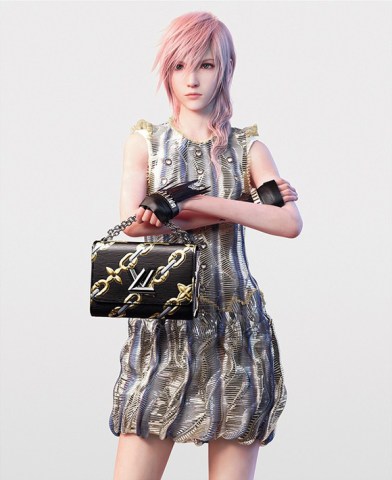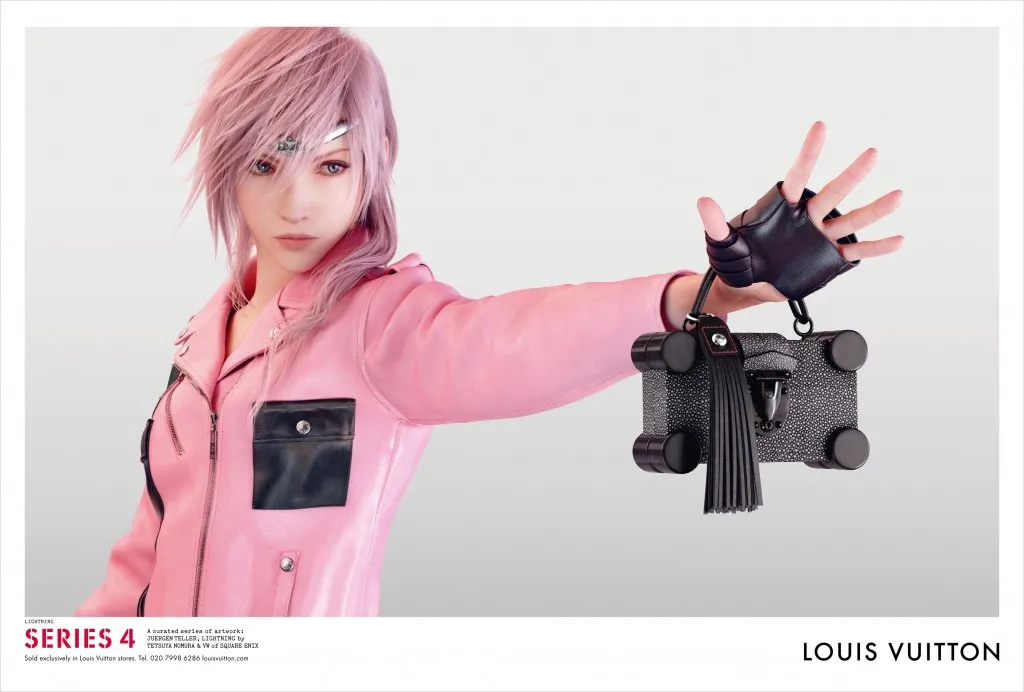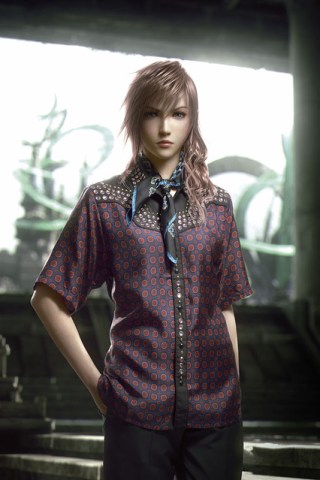I was in for a bit of a shock when I opened my February 2016 issue of Elle magazine this month. I flipped through the first few pages, which are always ads, right to a picture of a familiar face: stoic, pink haired, hand shot out decisively with small black clutch hanging off her fingertips. She was wearing a candy pink biker jacket, but this was no ordinary model: It was Lighting from Final Fantasy XIII (and its many sequels). A video game character modeling for a major fashion house, Louis Vuitton—and not just modeling, but headlining the campaign: Her ad was the largest of three, with the real human models coming after her. Of course I had heard about the collaboration earlier in January when it was announced, but somehow I had not expected to see it in a fashion magazine—certainly not a Western magazine—and yet there she was.
When this collaboration was first announced, naturally, I had a lot of thoughts. The first was, “Louis Vuitton? Really? That seems like an odd fit; I always thought of Lightning as more of an Alexander Wang kind of girl,” and the second was, “Why Louis Vuitton? Why Lightning? Why now?” But most of the context for the decision has not been talked about, just the hype itself. I wanted to dig a little deeper than the news posts have—news posts written primarily by people who don’t know the fashion industry at all. Ultimately, what I found is that the decision to use Lightning as a model says more about a shift in the fashion industry than it does about the video game one. Using Lightning as a model is a way to bring a new audience into the world of high fashion—a fashion house in the midst of trying to reshape its image, of modernizing, of understanding what a younger generation might be interested in.

(via Louis Vuitton/Square Enix Visual Works)
The history of Louis Vuitton is a long one, as most French fashion houses are, and almost as fantastic as anything that’s ever happened in a Final Fantasy game. Louis Vuitton was a real person, a French peasant (his father was a miller) who was born in 1821 and came to Paris at the tender age of 13 to learn how to make trunks from the esteemed Monsieur Maréchal. Not just any trunks, but trunks so beautiful and luxurious that they were fit for royalty. In 1852, after Louis-Napoleon staged a coup and reclaimed his place as the emperor of France, Vuitton became the personal trunk maker to the Empress Eugenie. By 1854, he had opened his first shop, but it wasn’t until 1858 when Vuitton had his real game-changing idea: he created a trunk that was made of grey canvas, not leather, that was lighter, more durable, and wouldn’t make your clothing smell the way that leather trunks did. But the real innovation was that it was rectangular, not round, which meant that his trunks could be stacked easily, an important feature in a new era of mass transportation, where space needed to be used wisely. They were so popular that Vuitton opened his own workshop outside of Paris. The brand quickly became known for using more modern materials to make its luggage, like canvas and glue, as well as using lighter colors, the most famous of which was known as Trianon grey.
Business was booming until the Franco-Prussian war, which destroyed Napoleon’s French empire for good, but resulted in a bloody civil war that left most of Paris and its surrounding environs, including the little village that contained Vuitton’s workshop, in ruins. But let’s not forget that this is a man who made a name for himself literally out of nothing, who came to Paris with nothing but the clothes on his back and wound up selling goods to royalty from around the world. He started over, and in 1871, he set up a new shop on what would become one of the most exclusive addresses in the new Paris, and the next year he debuted a new, simpler style of trunk made of beige canvas and red stripes, which France’s new elite went gaga over. This was the start of Louis Vuitton as a luxury brand, and his son Georges would continue the business after his death, creating the LV monogram that became so popular in the late 1990s. However, Louis Vuitton would not branch away from luggage and bags until the 1990s, after it was bought by the luxury firm now known as LVMH.
LVMH head Bernard Arnault didn’t make Vuitton a fashion house until 1997, when he hired fashion’s current badboy wunderkind, Marc Jacobs, as creative director for the brand’s ready-to-wear lines. Jacobs played it safe with the first collection, paying tribute to Trianon grey with a collection made up entirely of white and grey, with the famous LV monogram hidden on the inside. Jacobs wouldn’t stay so muted for long, and the brand quickly became associated with the celebrity driven, party girl lifestyle of the late ’90s and early 2000s. The LV monogram would become famous again as Jacobs plastered it across almost every bag known to existence, and many other brands followed suit, starting the labelmania trend that’s come to define that period of time. Marc Jacobs remained as creative director until 2013, when he unexpectedly stepped down after the Spring/Summer 2014 show, which, although done entirely in shades of black, lacked none of Jacobs’ flamboyant showmanship. Nicolas Ghesquière, formerly of Balenciaga, took over as creative director the month following Jacobs’ announcement.
When Ghesquière came on board, it was clear he wanted to put his own fresh stamp on things. His first collection was a flurry of new ideas for the brand: new prints, new bag shapes, new fabrics, even new models. Everyone who went to his first show received a note from him reading, “This is a new day.” Vogue UK described the show as “fresh, glossy and modern.” Two years later, Ghesquière is still fairly new at the brand and is still trying to distinguish it from Jacobs-era Vuitton. In a way, by casting a video game character as his latest “it” girl, he’s doing the same thing that Marc Jacobs did when he made Jennifer Lopez the face of the brand in 2003: stirring up the status quo of the fashion world while reaching a younger, hipper audience.
Since video game playing has never before been so universal, it makes perfect sense, but most important is the fact that the Louis Vuitton Spring/Summer 2016 collection is pretty much entirely inspired by geek culture: TRON Legacy, the Wong Kar-wai film 2046, Sense 8, and Evangelion are all cited reference points for this collection. The models even walked the runway to music from Minecraft. A computerized voice literally introduced the show as a “journey to the frontiers of the digital era.” With its Sailor Moon-esque metal headbands, biker influences, and candy floss colors, this collection is a love letter to a younger, digitally savvy generation. It only makes sense that the collection’s ambassador would be a digital creation. While Lightning might not initially seem like a great first choice, she does look great in (the majority) of the Spring/Summer 2015 collection. It also doesn’t hurt that she looks like the model-du-jour: edgy and pink haired, like Fernanda Hin Lin Ly and Charlotte Free.
There’s another important reason why Lightning was chosen as the face for this campaign: the Asian luxury market. It’s no secret in the fashion world that the Asian market is currently much more valuable to luxury brands than the Western one. It’s where the money is and has been for quite some time now, so brands like Louis Vuitton have been focusing on opening more stores in Asia and are more focused on reaching that consumer. However, sales have been falling recently, and luxury with an edge seems to be a growing trend there. Brands like Balenciaga (yep, the design house that Ghesquière used to run—not a coincidence), with a more rock and roll sensibility, but also less tolerance for logos, is what the Asian luxury consumer is looking for. The LV S/S 2016 collection fits this bill to a T. Even the famous LV monogram is gone, replaced with simple brass fittings on the handles that seem to blend into the bags, if it’s there at all. And while Lightning is probably not the most famous Final Fantasy heroine in the West, she definitely is in Japan. It isn’t even her first high fashion campaign: The whole Final Fantasy XIII cast was decked out in Prada for a photo spread for Japanese magazine Arena Homme+ way back in 2012.
Of course, it’s not like Square Enix gets nothing out of this either—they get coverage in both video game publications and fashion ones, and the whole thing spread through Games Twitter like wildfire when it was announced. That’s no small currency when you have your first next-gen title for the series released this year, but does this signal a huge shift in the way fashion will be used in games, or with fashion’s relationship with games? Probably not. Not anytime soon, anyway. Square Enix is pretty outside-the-box in their willingness to collaborate with the fashion world (Final Fantasy XV might be first game to have an actual fashion designer create some of the characters’ wardrobes). Instead, it’s more about Nicolas Ghesquière redefining a fashion house for a digital age, while reaching out to a lucrative market. It’s possible this could eventually set a trend in the industry and make way for more collaboration down the line, but I wouldn’t hold my breath. (This is my invitation to prove me wrong, AAA videogame industry!)
Megan Patterson is a freelance writer and the science and tech editor of Paper Droids, a feminist geek culture site. When she’s not writing, you can find her on Twitter, talking about how cute she is or crying over something ridiculous (usually videogames).
—Please make note of The Mary Sue’s general comment policy.—
Do you follow The Mary Sue on Twitter, Facebook, Tumblr, Pinterest, & Google +?









